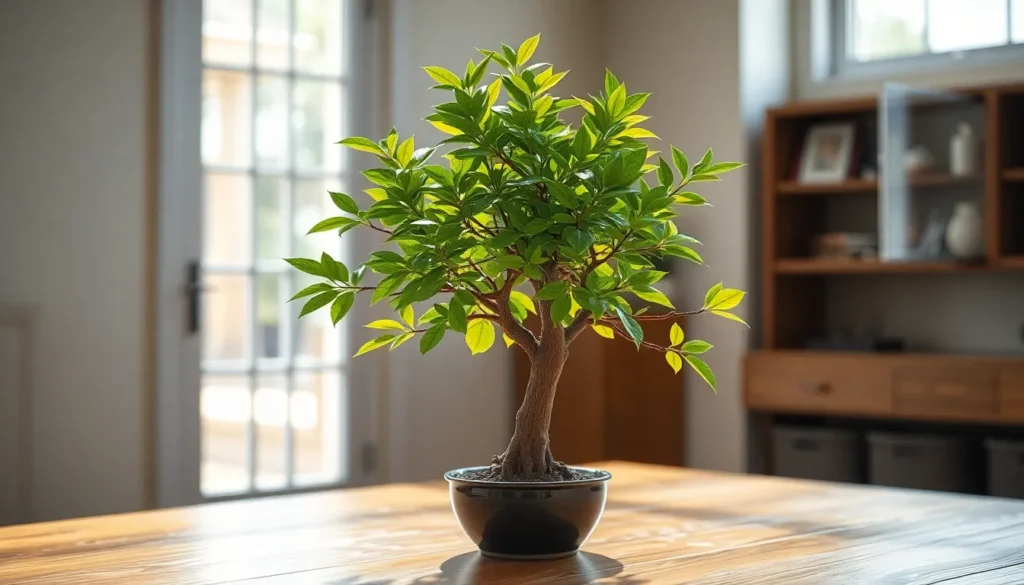Money trees have captured our hearts with their braided trunks and glossy green leaves but they’re notorious for being finicky about water. We’ve all been there – watching helplessly as our beloved Pachira aquatica drops leaves or develops root rot because we couldn’t crack the watering code.
The truth is most money tree problems stem from watering mistakes. Too much water kills more money trees than drought ever will. These tropical beauties need just the right balance to thrive and reward us with their stunning foliage and good fortune symbolism.
Getting money tree watering right isn’t rocket science once you understand their natural habitat and needs. We’ll show you exactly when to water how much to give and what signs to watch for so your money tree stays healthy and vibrant year-round.
Understanding Your Money Tree’s Natural Watering Needs
We’ve established that proper watering forms the foundation of money tree care. Now let’s explore how these tropical plants naturally receive water in their environment.
Native Habitat and Water Requirements
Money trees originate from the wetlands and swamps of Central and South America where they experience distinct wet and dry cycles. These regions receive 60-80 inches of rainfall annually with pronounced seasonal variations that create natural drought periods followed by abundant moisture.
Wild money trees develop extensive root systems that can access groundwater during dry spells while quickly absorbing surface water during rainy seasons. Their native soil consists of well-draining sandy loam mixed with organic matter that prevents water from pooling around the roots.
Humidity levels in their natural habitat range from 60-90% throughout the year. This high ambient moisture allows money trees to supplement their water intake through their braided bark and glossy leaves.
Temperature fluctuations between 65-85°F in their native environment influence their metabolic rate and water consumption patterns. Cooler nighttime temperatures reduce transpiration while warm days increase their water uptake needs.
Signs of a Healthy Hydrated Money Tree
Well-watered money trees display vibrant green leaves with a glossy surface that feels firm to the touch. Each leaflet maintains its natural upright position without drooping or curling at the edges.
Healthy stems remain sturdy and maintain their natural braided formation without becoming soft or mushy. The bark should feel slightly firm with no dark spots or soft patches that indicate overwatering damage.
Soil moisture levels stay consistent in properly hydrated plants with the top 2-3 inches feeling slightly dry between waterings. This balanced moisture prevents both drought stress and waterlogged conditions.
New growth appears regularly on healthy money trees with fresh shoots emerging from the top and sides of the main stems. These new leaves start as bright green buds that unfurl into full-sized leaflets within 2-3 weeks.
Root health remains optimal when you observe white or cream-colored roots during repotting sessions. Healthy roots feel firm and show no signs of blackening or mushiness that indicates root rot from excessive moisture.
Determining the Right Watering Frequency for Money Trees
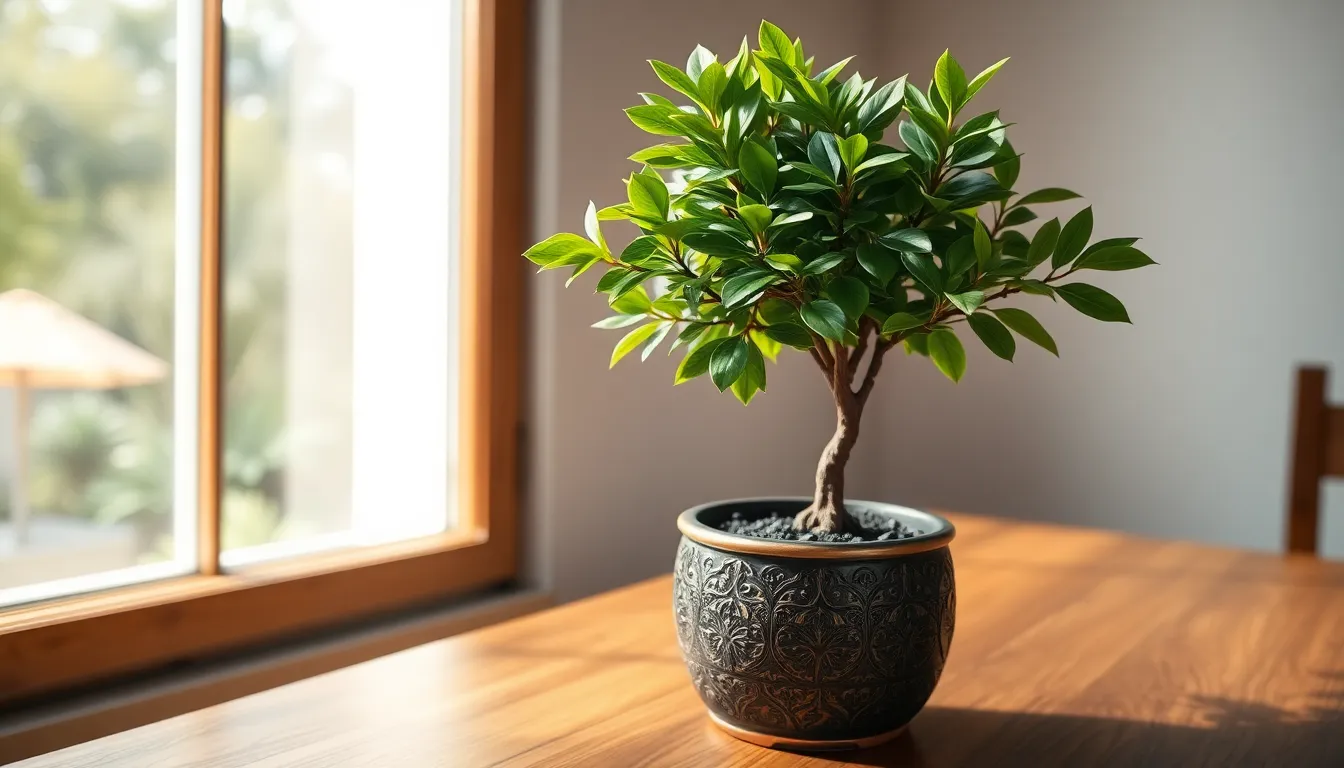
We recommend watering money trees once every one to two weeks, though this timing depends on several environmental factors. Check the top 2 inches of soil before watering – if they feel dry, it’s time to give your plant a drink.
Seasonal Watering Schedule Adjustments
Spring and Summer require more frequent watering as money trees enter their active growing phase. During these warmer months, we’ll need to monitor soil moisture more closely since increased light and temperature cause faster water evaporation.
Winter calls for reduced watering frequency as money trees become dormant. We should water only once every 2 to 3 weeks during the colder months, allowing the plant to rest and preventing root rot from oversaturated soil.
Factors That Affect Watering Frequency
Humidity levels directly impact how quickly soil dries out. Drier conditions mean we’ll need to water more frequently, while higher humidity allows for longer intervals between watering sessions.
Light exposure accelerates soil drying, so money trees in brighter locations require more frequent watering. Plants receiving direct sunlight will need water more often than those in lower light conditions.
Weather patterns significantly influence watering schedules throughout the year. Hot and dry weather necessitates more frequent watering, whereas cooler conditions require less water input from us.
Pot size determines how quickly soil moisture depletes. Smaller pots dry out faster than larger ones, meaning we’ll water plants in compact containers more frequently than those with ample root space.
Watering technique matters as much as frequency – we should water thoroughly until about 20% of the water drains from the pot’s drainage holes. Allow the top 2 to 4 inches of soil to dry between waterings while maintaining gentle humidity around 50% to prevent leaf damage.
Recognizing When Your Money Tree Needs Water
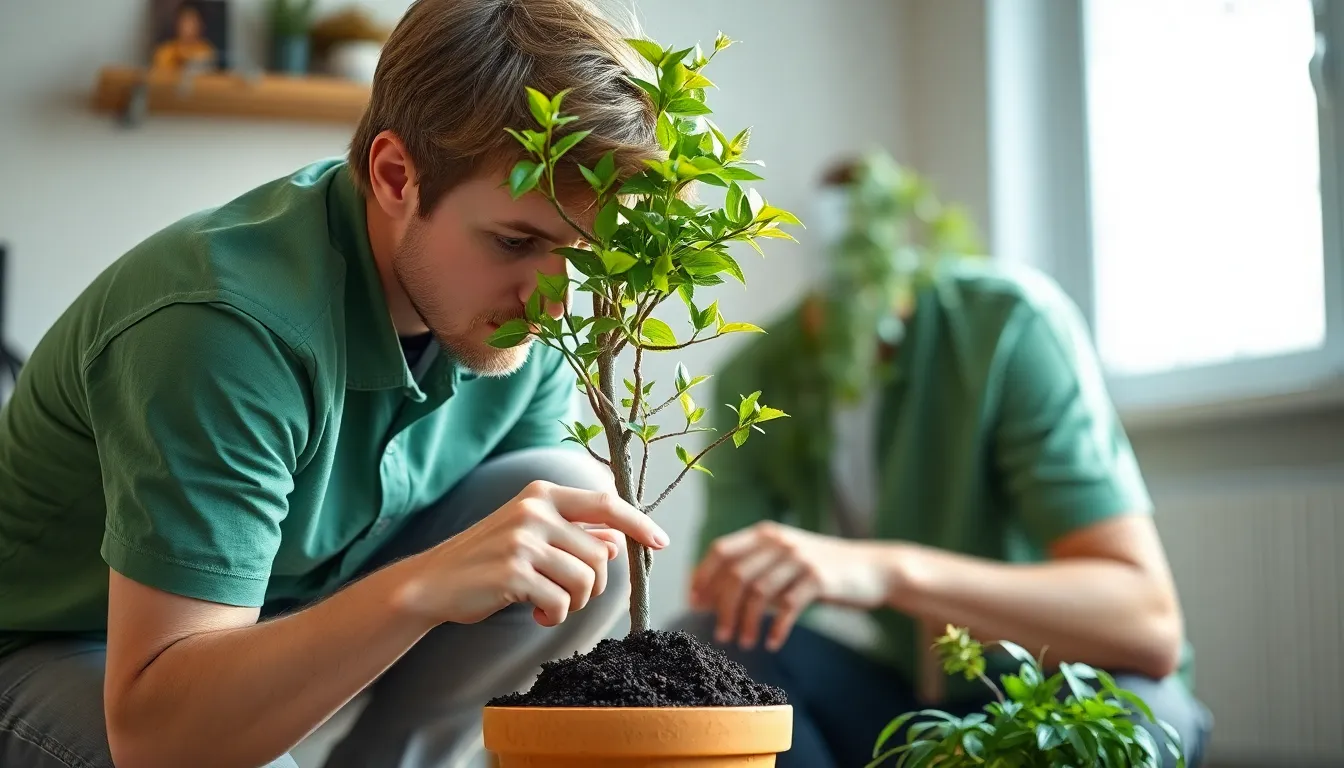
Understanding when to water your money tree prevents the common pitfalls of over and under watering that can damage these resilient plants. We’ll explore reliable methods to assess your plant’s hydration needs through soil testing and visual observation.
Soil Moisture Testing Techniques
Insert your finger into the soil to check moisture levels at a depth of 2 to 4 inches before watering your money tree. We recommend this simple finger test as the most reliable method since money trees store water in their thick trunks and don’t require frequent watering.
Push a wooden stick or skewer into the potting mix to gauge moisture deeper in the root zone. Dry soil at this depth indicates it’s time for thorough watering, while moist soil means you should wait longer.
Use a moisture meter for more precise readings if you prefer a scientific approach to plant care. These digital tools eliminate guesswork and provide consistent measurements across different areas of the pot.
Allow excess water to drain completely from the pot’s drainage holes after watering to prevent waterlogging and root rot. We always ensure proper drainage since money trees can’t tolerate standing water around their root systems.
Visual Cues from Leaves and Stems
Check for yellowing or dropping leaves as these symptoms often signal overwatering or poor drainage in your money tree. We’ve found that healthy leaves maintain their firm texture and vibrant green color when properly hydrated.
Look for brown, crispy leaf edges which indicate under watering or insufficient humidity levels around your plant. These visual signs help distinguish between too much and too little water.
Lift the pot to assess its weight since dry soil makes containers noticeably lighter than when properly moistened. We use this quick check alongside other methods to confirm watering timing.
Observe the trunk for slight wrinkling though this rare occurrence only happens under severe water stress in indoor conditions. Well maintained money trees rarely show this extreme symptom of dehydration.
Examine the overall leaf appearance for firmness and color consistency as drooping or dull foliage can indicate hydration issues. We monitor these visual changes to catch watering problems before they become serious.
Mastering the Proper Money Tree Watering Technique
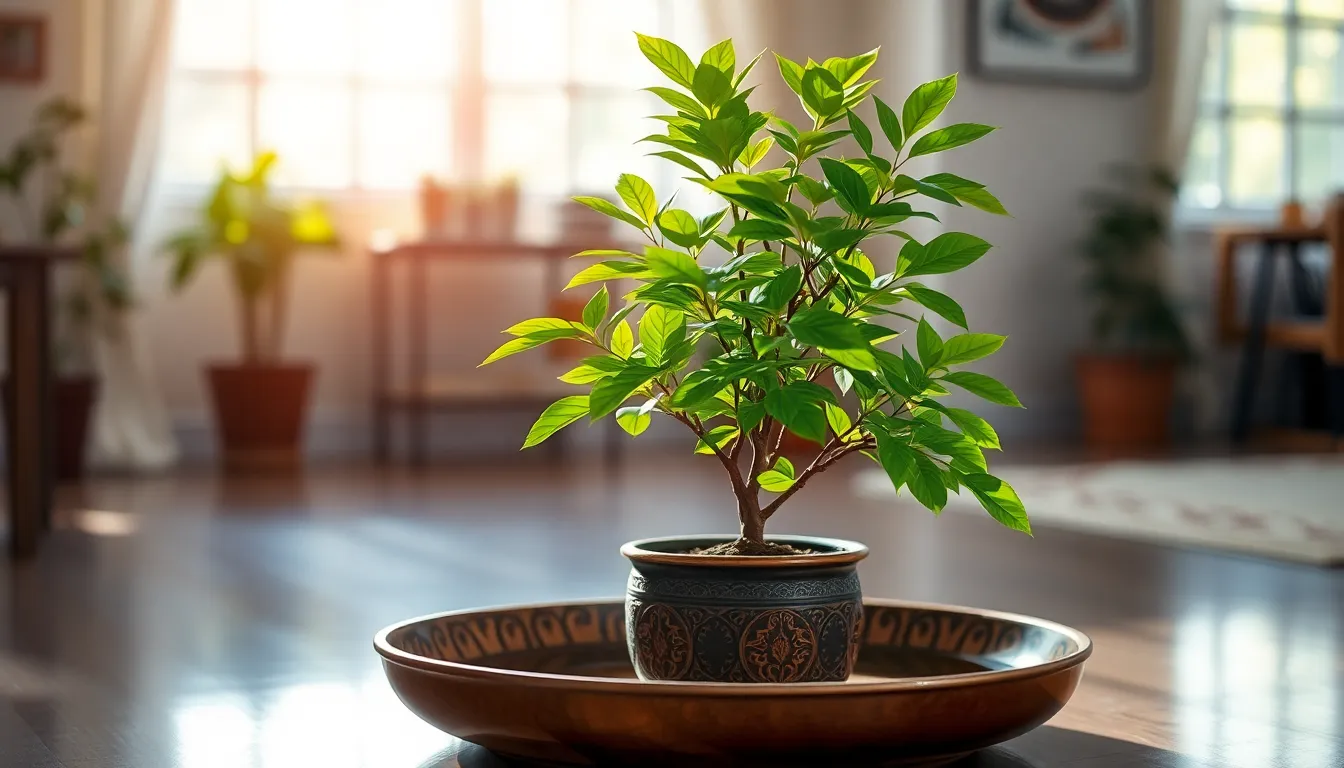
Now that we’ve learned how to recognize when our money tree needs water, let’s explore the most effective techniques to deliver that hydration properly.
Bottom-Up Watering Method
Bottom-up watering involves placing our money tree’s pot in a water-filled saucer and allowing the plant to absorb moisture through its drainage holes. This technique can help prevent overwatering since the plant only takes what it needs from below.
We place the pot in a shallow tray filled with about an inch of water and let it sit for 30-45 minutes. Our money tree will naturally draw water upward through the soil, ensuring even moisture distribution throughout the root system.
This method works well for money trees because it mimics their natural wetland environment where roots access groundwater from below. But, we should use this technique sparingly since money trees store substantial water in their trunks and don’t require frequent watering.
Top-Down Watering Best Practices
Top-down watering remains the most recommended approach for money trees, giving us better control over the watering process. We should water our money tree when the soil volume reaches 50-75% dryness, which typically occurs every three weeks.
Proper watering technique requires us to:
- Pour water slowly and evenly across the soil surface
- Continue watering until we see water flowing from the drainage holes
- Immediately discard any excess water that collects in the saucer
Optimal water amounts include:
- 6-8 ounces of water every three weeks for average-sized money trees
- Two ice cubes weekly as an alternative measuring method
- Thorough saturation until 20% of applied water drains out
Well-draining potting mix becomes essential for preventing root rot and protecting against overwatering issues. We must ensure our money tree never sits in standing water, as this contradicts their natural wet-dry cycle preferences.
Misting the leaves occasionally helps maintain the humid environment money trees prefer while avoiding soil oversaturation. This supplemental humidity supports healthy growth without compromising the root system’s integrity.
Choosing the Best Water Quality for Your Money Tree
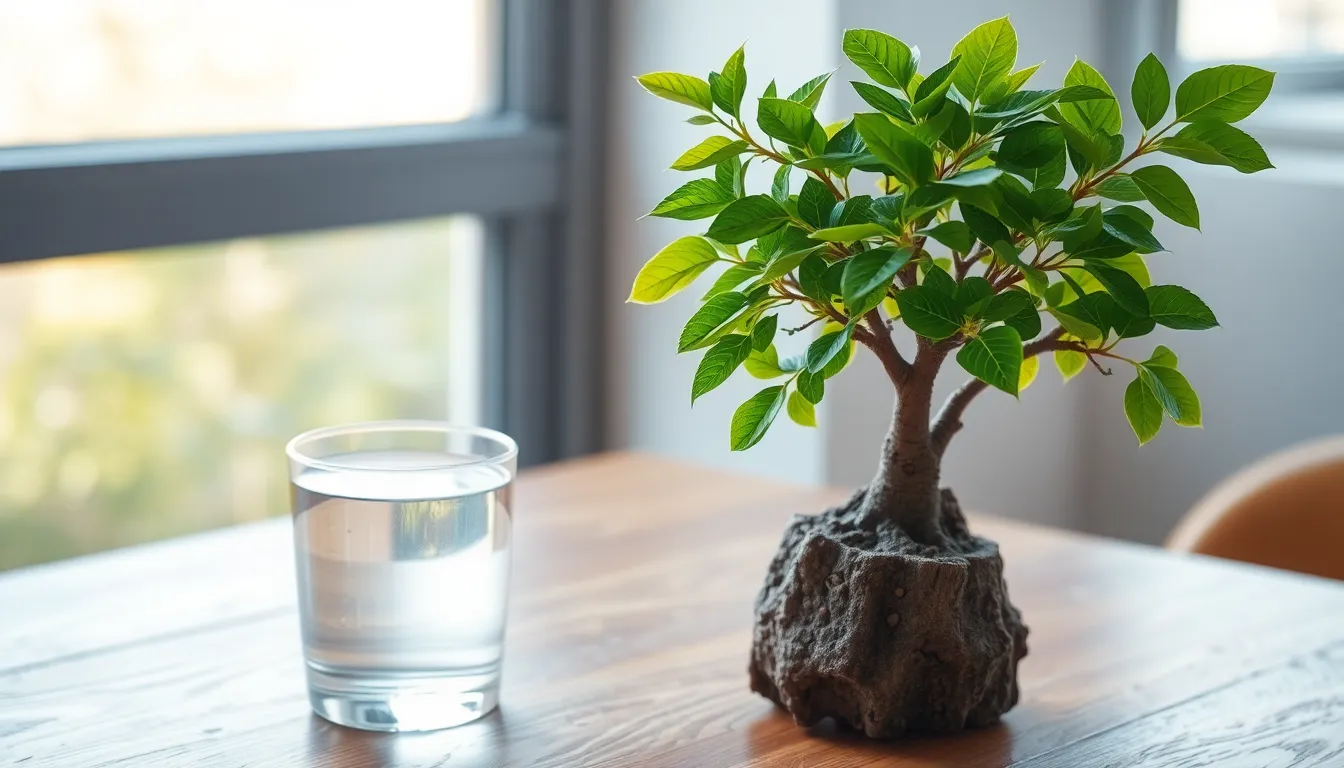
Selecting the right water quality forms the foundation of successful money tree care alongside proper watering techniques.
Filtered vs. Tap Water Considerations
Most tap water works perfectly fine for money trees without requiring expensive filtration systems. We recommend testing your tap water first since many municipal water supplies provide adequate quality for indoor plants.
High mineral content becomes problematic when your tap water contains excessive salts or minerals that accumulate in the soil over time. These buildups create white crusty deposits on the soil surface and can eventually damage root health.
Filtered water offers benefits when your tap water shows signs of heavy mineralization or chemical treatment. Consider switching to filtered water if you notice:
- White mineral deposits forming on soil or pot edges
- Leaf tips turning brown even though proper watering schedules
- Slow growth patterns in otherwise healthy plants
- Strong chlorine odors from your tap water
Distilled water requires caution since it lacks essential minerals that money trees need for healthy growth. We suggest mixing distilled water with tap water at a 50/50 ratio if you prefer using purified water.
Rainwater provides excellent results when collected properly and stored in clean containers. This natural option contains the right mineral balance without harmful chemicals or excessive salts.
Temperature Guidelines for Watering
Room temperature water prevents root shock and maintains optimal growing conditions for your money tree. We always recommend allowing water to reach room temperature before watering sessions.
Cold water creates stress by shocking the root system and potentially slowing nutrient absorption. Water temperatures below 60°F can cause temporary growth disruption and leaf dropping.
Hot water damages delicate roots and can cook plant tissues on contact. Temperatures above 85°F pose serious risks to root health and overall plant vitality.
Testing water temperature takes seconds using your wrist or a simple thermometer. Aim for temperatures between 65°F and 75°F for optimal results.
Consistent temperature matters more than achieving perfect measurements every time. We find that maintaining steady room temperature water creates the most reliable watering routine for healthy money tree growth.
Avoiding Common Money Tree Watering Mistakes
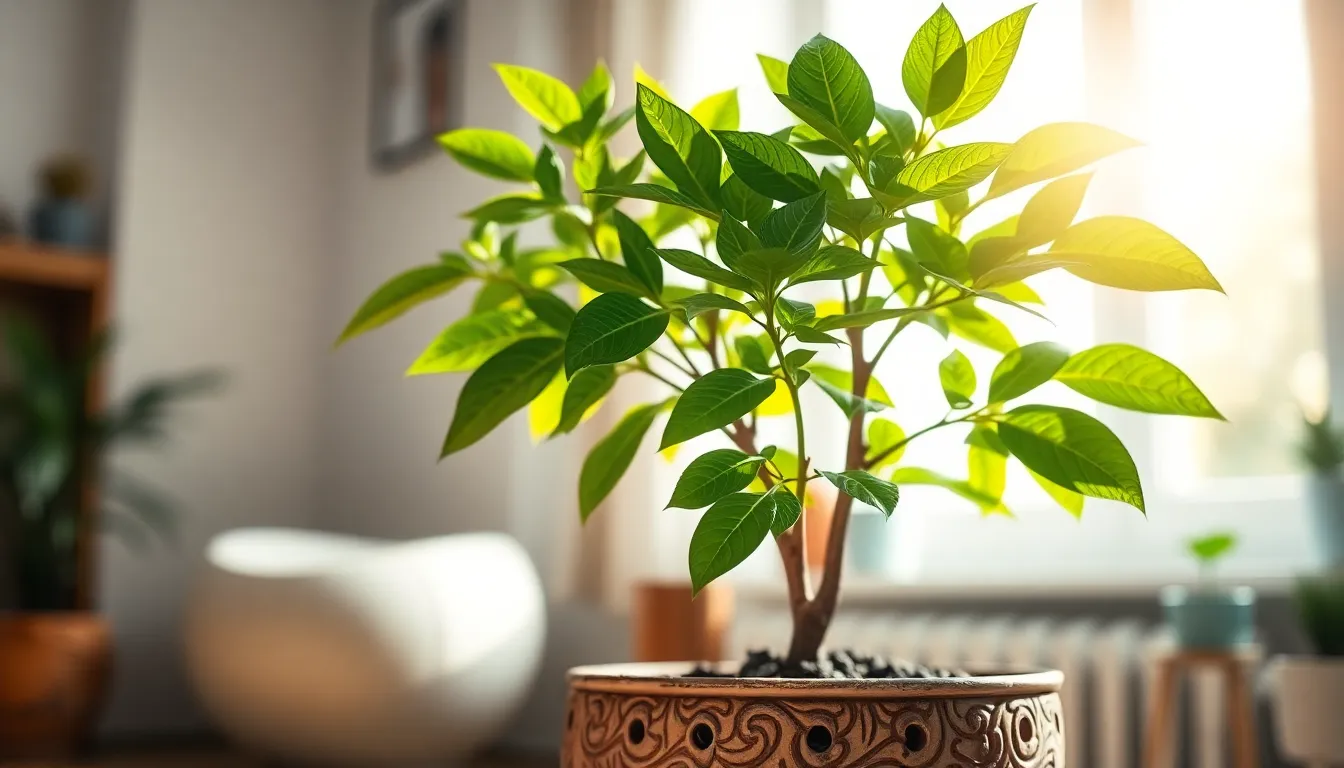
Even experienced plant parents make watering errors that can seriously damage their money trees. We’ll explore the most common mistakes and provide proven answers to keep your plant thriving.
Overwatering Warning Signs and Answers
Yellow or brown leaves signal the most common money tree watering mistake we encounter. Overwatering creates waterlogged conditions that prevent roots from accessing oxygen, causing leaves to turn yellow and eventually brown as the plant struggles to survive.
Soft stems indicate advanced overwatering damage that requires immediate attention. We check stem firmness by gently pressing the trunk area, and if it feels mushy or gives way under light pressure, root rot has likely begun affecting the plant’s structural integrity.
Root rot presents as black, mushy roots when we remove the plant from its pot for inspection. This fungal condition thrives in consistently wet soil and can kill a money tree within weeks if left untreated.
Reduce watering frequency immediately when you notice these warning signs. We recommend waiting until the top 50-75% of soil feels completely dry before the next watering session, which typically extends the schedule from weekly to every two weeks or longer.
Ensure proper drainage by checking that your pot has adequate drainage holes and using well-draining soil. We replace soggy potting mix with fresh, fast-draining soil to prevent water from pooling around the roots.
Avoid letting plants sit in standing water by emptying saucers and drip trays within 30 minutes after watering. We never allow money trees to remain in water-filled containers, as this creates the exact conditions that promote root rot and stem decay.
Underwatering Symptoms and Recovery
Wilting leaves appear droopy and lack their usual upright posture when money trees don’t receive adequate moisture. We notice this symptom first in the lower leaves, which become soft and begin to curl inward as the plant conserves water for newer growth.
Dry soil extends beyond the surface layer when underwatering occurs regularly. We test soil moisture by inserting our finger 2-3 inches deep, and completely dry soil at this depth indicates the plant needs immediate hydration.
Increase watering frequency slightly rather than drastically changing your schedule when addressing underwatering. We recommend moving from every two weeks to every 10 days, allowing gradual adjustment without shocking the root system.
Check soil dryness before each watering to establish a consistent routine that prevents future underwatering episodes. We use the finger test or a wooden skewer to assess moisture levels at multiple depths, ensuring accuracy before adding water.
Monitor recovery progress over the following weeks as properly hydrated money trees restore their natural leaf position and color. We expect to see improvement within 7-10 days, with full recovery typically occurring within 2-3 weeks of consistent proper watering.
Creating an Optimal Drainage System for Money Tree Watering
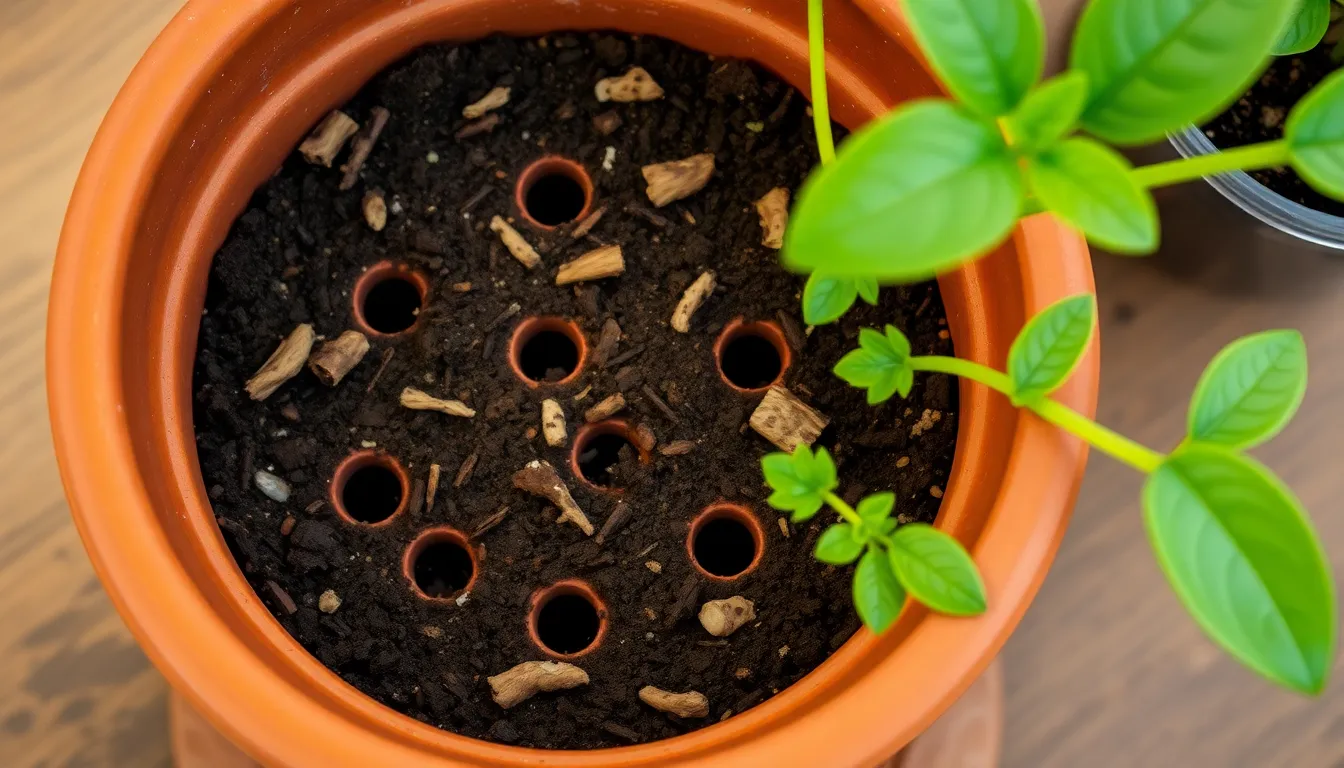
Establishing proper drainage prevents the waterlogging issues that commonly plague money tree owners. We’ll focus on the essential components that keep your plant’s roots healthy and thriving.
Selecting the Right Pot and Drainage Holes
Choose containers with multiple drainage holes to prevent water accumulation in the soil. Standard pots need at least 3-4 holes spread across the bottom surface. Terra cotta and ceramic pots with built-in elevated bottoms work exceptionally well since they keep roots from sitting directly in standing water.
Look for pots that allow approximately 20% of water to drain out during each watering session. This drainage percentage ensures thorough soil saturation without creating soggy conditions. Containers with saucers underneath should have the excess water removed within 30 minutes of watering.
Avoid decorative pots without drainage holes or those with only single small openings. These containers trap moisture and create the perfect environment for root rot development. Drill additional holes if your favorite pot lacks adequate drainage options.
Soil Mix Requirements for Proper Water Flow
Create well-draining soil by mixing standard potting soil with perlite or coarse sand. The ideal ratio combines 2 parts quality potting mix with 1 part drainage amendment. This combination prevents the moisture retention problems that occur with regular potting soil alone.
Incorporate materials like bark chips or pumice to improve soil aeration around money tree roots. These components create air pockets that allow excess water to flow through quickly. Avoid fine materials like vermiculite that can actually increase water retention.
Test your soil mix by watering thoroughly and checking how quickly water drains from the bottom holes. Proper drainage occurs when water flows steadily through the soil within 2-3 minutes of application. Slow drainage indicates the need for more perlite or sand amendments.
Replace soil every 18-24 months as organic components break down and reduce drainage efficiency. Fresh soil maintains the proper water flow characteristics your money tree needs. Compacted or decomposed soil creates the waterlogged conditions that lead to root problems.
Adjusting Money Tree Watering Based on Environmental Conditions
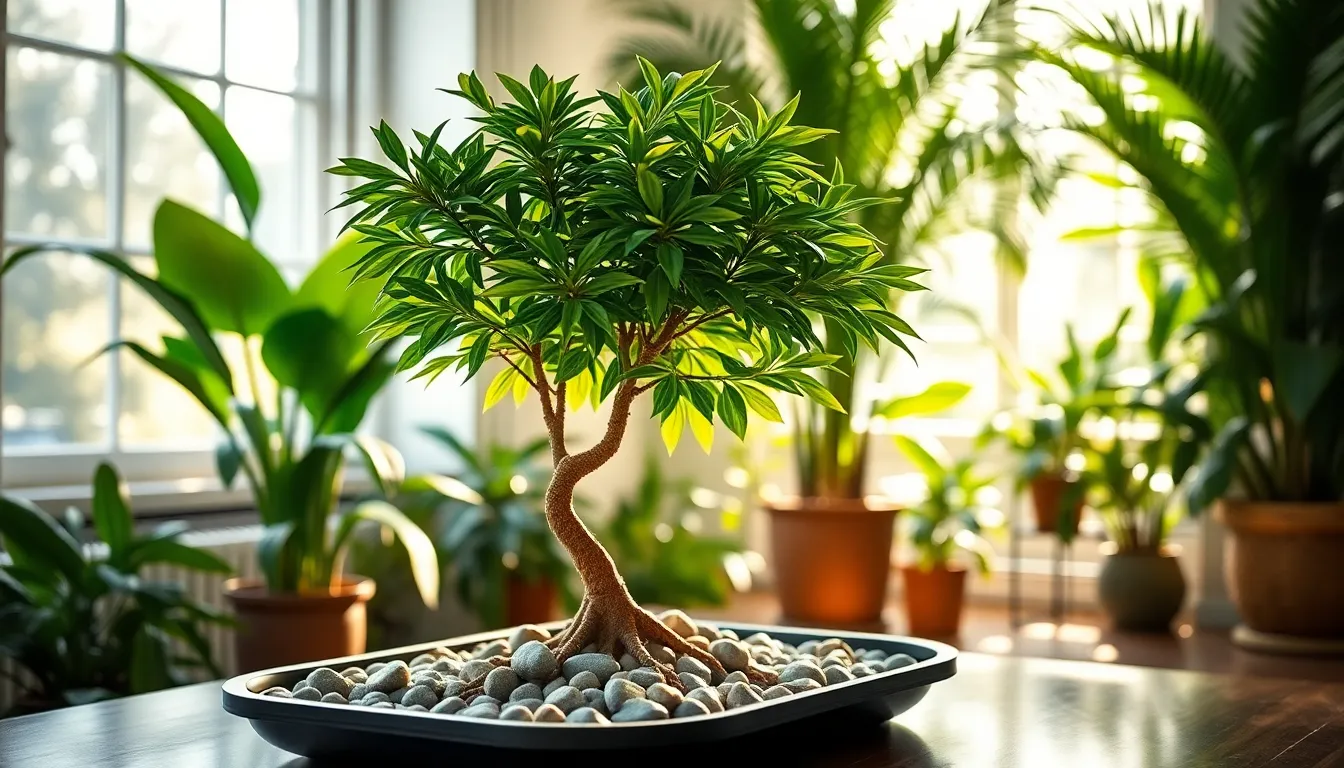
Environmental factors significantly influence how often we need to water our money trees. Understanding these conditions helps us create the perfect watering schedule for optimal plant health.
Humidity Level Considerations
Money trees thrive when humidity levels hover around 50%, which creates ideal growing conditions for these tropical plants. Dry environments present challenges, especially during winter months when indoor heating systems reduce moisture in the air.
Maintaining proper humidity becomes crucial to prevent crispy leaf edges and overall plant stress. We can place our money tree on a tray filled with wet pebbles to naturally increase humidity around the foliage. This simple technique creates a microclimate that mimics the plant’s native wetland environment.
Low humidity environments require more frequent watering since dry air pulls moisture from both soil and leaves faster than normal. During these conditions, we should monitor soil moisture more closely and expect to water slightly more often than our standard schedule.
Grouping plants together also helps maintain humidity levels as multiple plants release moisture through transpiration. This natural process creates a more stable environment for our money tree without requiring additional equipment or daily maintenance.
Light and Temperature Impact on Water Needs
Light exposure directly affects how quickly our money tree uses water through transpiration and photosynthesis. Brighter light conditions increase the plant’s metabolic rate, leading to faster water consumption and more frequent watering needs.
Medium light conditions work best for money trees as they provide adequate energy without causing excessive water loss. We should avoid placing our plant in direct sunlight, which can rapidly dry out the soil and stress the root system.
Temperature preferences for money trees range between 65°F to 75°F (18°C to 24°C), creating optimal growing conditions. Higher temperatures increase water evaporation from soil and boost the plant’s transpiration rate, requiring us to water more frequently.
Cooler temperatures slow down plant metabolism and reduce water uptake, meaning we can extend time between waterings during colder months. We should adjust our watering schedule seasonally to match these temperature variations.
Combining bright light with high temperatures creates maximum water demand for our money tree. During these conditions, we might need to water every week instead of our typical 1-2 week schedule, while monitoring soil moisture levels closely to prevent both drought stress and overwatering.
Troubleshooting Money Tree Watering Problems
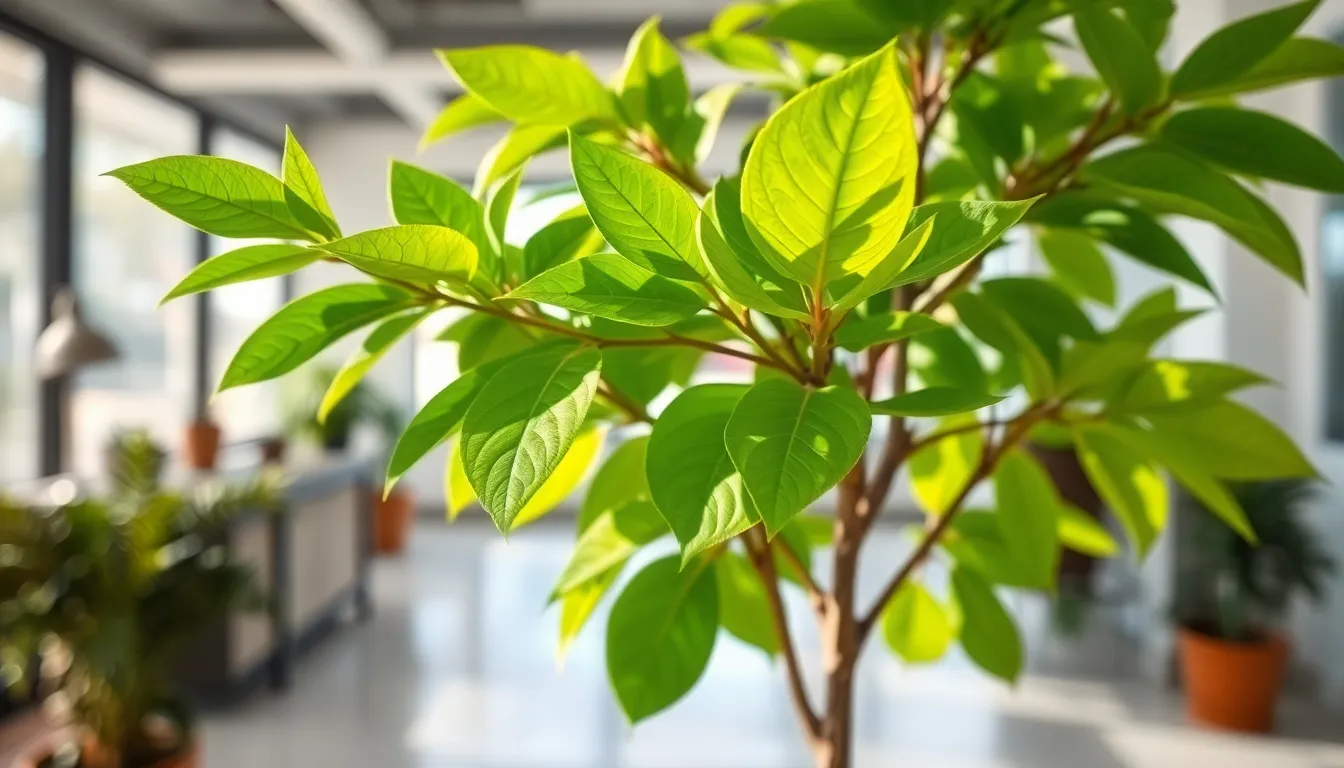
Even with proper watering techniques, we might encounter exact issues that require targeted answers. Understanding these problems helps us maintain our money tree’s health and prevent permanent damage.
Yellow Leaves and Water-Related Issues
Yellow leaves serve as the primary indicator of overwatering in money trees. Excess moisture suffocates the roots and prevents proper nutrient absorption, causing leaves to turn yellow and eventually drop from the plant.
Identifying overwatering symptoms:
- Leaves develop a yellow coloration starting from the bottom of the plant
- Dropping occurs more frequently than normal leaf shedding
- Soil remains consistently soggy or waterlogged between watering sessions
- Plant exhibits poor overall growth even though regular care
Correcting yellow leaf problems:
- Reduce watering frequency immediately when yellow leaves appear
- Check soil moisture before each watering session using the finger test
- Water only when the top 2 to 4 inches of soil feels completely dry
- Remove standing water from saucers and trays within 30 minutes of watering
- Ensure pots have adequate drainage holes to prevent water accumulation
Recovery typically occurs within 2 to 4 weeks when we adjust our watering schedule appropriately. New growth signals that our money tree has recovered from the overwatering stress.
Root Rot Prevention and Treatment
Root rot develops when roots remain saturated for prolonged periods, creating anaerobic conditions that promote harmful bacteria and fungi. Prevention requires maintaining proper soil moisture levels and ensuring adequate drainage throughout the growing medium.
Prevention strategies:
- Allow soil to partially dry between each watering session
- Use pots with multiple drainage holes to help water flow
- Apply the bottom watering method by placing the pot in water for 30 minutes
- Clear any standing water from saucers after the soaking period
- Monitor soil drainage and replace it every 18 to 24 months
Treatment for existing root rot:
- Remove the plant from its current pot and examine the root system
- Cut away soft, brown, or mushy roots using sterilized pruning shears
- Rinse remaining healthy roots with clean water to remove infected material
- Repot the plant in fresh, well draining potting mix immediately
- Reduce watering frequency during the recovery period
Recovery monitoring:
- Watch for new growth within 4 to 6 weeks of treatment
- Maintain high humidity around 50% to support root regeneration
- Fertilize only during active growing seasons to avoid stressing recovering roots
- Check drainage regularly to prevent future root rot occurrences
Successful treatment depends on early detection and prompt action when we notice the first signs of root deterioration.
Establishing a Sustainable Money Tree Watering Routine
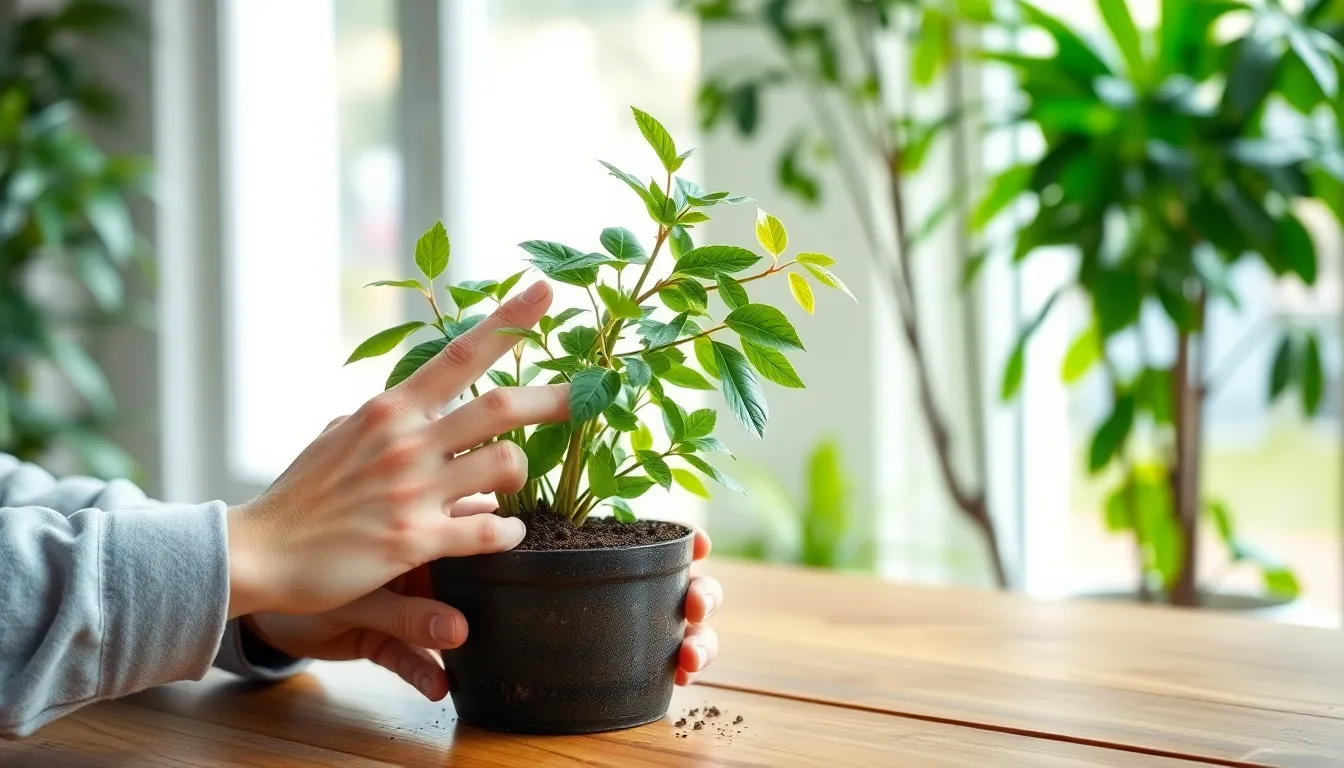
Money trees store water in their trunks naturally, making them drought tolerant plants that don’t need constant attention. Building a consistent routine helps us avoid the common mistakes that lead to plant stress.
Creating a Watering Schedule That Works
Base your schedule on soil dryness rather than calendar dates for the most effective approach. Money trees thrive when we water them after the soil reaches 50-75% dryness, which typically happens every 1-2 weeks depending on environmental conditions.
Summer months require more frequent attention as increased heat and light cause faster soil drying. During these active growing periods, we might need to water weekly to maintain proper hydration levels.
Winter schedules should be adjusted downward since money trees enter a dormant phase with reduced water uptake. Environmental factors like humidity, temperature, and pot size all influence how quickly soil dries out.
Bottom watering provides excellent results by placing the pot in a water filled saucer and allowing absorption through drainage holes. This method prevents overwatering while ensuring thorough soil saturation.
Monitoring Tools and Techniques
| Method | Frequency | Measurement |
|---|---|---|
| Finger Test | Weekly | Check soil 1-2 inches deep |
| Water Amount | Per Session | 6-8 ounces for small plants |
| Watering Interval | Regular | Every 3 weeks for small plants |
Soil moisture checking gives us the most reliable watering indicator by inserting our finger into the soil up to the first knuckle. Dry soil at this depth signals it’s time to water thoroughly.
Measuring water amounts helps maintain consistency in our watering routine. Small money trees typically need 6-8 ounces of water every three weeks, while larger specimens require proportionally more.
Drainage monitoring ensures we’re watering correctly by observing water flow from the pot’s drainage holes. Proper watering continues until water emerges from the bottom, then we discard any excess to prevent root rot.
Humidity tracking supports overall plant health since money trees prefer humid environments. Occasional misting or using a humidifier supplements our watering routine without oversaturating the soil.
Conclusion
Mastering money tree watering isn’t about following rigid schedules—it’s about understanding your plant’s unique needs and responding accordingly. We’ve shown you that these resilient plants thrive when we let the soil guide our watering decisions rather than the calendar.
Success comes from observing the soil moisture checking the top 2-4 inches for dryness and adjusting our approach based on seasonal changes. Remember that your money tree’s health depends on consistent monitoring and gradual adjustments rather than dramatic changes.
With the techniques we’ve shared—from proper drainage to bottom watering methods—you’re now equipped to keep your money tree healthy year-round. Trust the process stay attentive to your plant’s signals and you’ll enjoy a thriving money tree that brings both beauty and prosperity to your space.
Frequently Asked Questions
How often should I water my money tree?
Water your money tree once every 1-2 weeks, checking the top 2 inches of soil for dryness before watering. During spring and summer growing seasons, you may need to water more frequently due to increased evaporation. In winter, reduce watering frequency as the plant enters a dormant phase and requires less moisture.
What are the signs of overwatering a money tree?
Overwatered money trees display yellow or brown leaves, soft or mushy stems, and may develop root rot. The soil will feel consistently wet, and you might notice a musty smell from the pot. If you see these symptoms, immediately reduce watering frequency and ensure proper drainage to prevent further damage.
How much water should I give my money tree?
Water thoroughly until about 20% of the water drains from the pot’s drainage holes. The amount varies by plant size, but ensure complete soil saturation. Allow the top 2-4 inches of soil to dry between waterings, and maintain humidity levels around 50% for optimal plant health.
What is the best watering technique for money trees?
Bottom watering is highly effective for money trees. Place the pot in a water-filled saucer and let it absorb moisture through drainage holes for 30-45 minutes. This method prevents overwatering while ensuring thorough soil saturation and encourages healthy root development throughout the pot.
How do I know if my money tree needs water?
Perform the finger test by inserting your finger 2 inches into the soil. If it feels dry, it’s time to water. Additionally, check for slightly drooping leaves or soil that pulls away from the pot edges. Healthy money trees should have vibrant green leaves and consistently moist (not wet) soil.
Can I use tap water for my money tree?
Yes, most tap water is suitable for money trees, but let it sit for 24 hours to allow chlorine to evaporate. If your tap water is heavily treated or has high mineral content, consider using filtered or distilled water. Room temperature water is best to avoid shocking the plant’s roots.
What should I do if my money tree has root rot?
If you suspect root rot, immediately remove the plant from its pot and inspect the roots. Cut away any black, mushy, or foul-smelling roots with sterile scissors. Repot in fresh, well-draining soil and reduce watering frequency. Ensure the new pot has adequate drainage holes to prevent future issues.
Why are my money tree leaves turning yellow?
Yellow leaves typically indicate overwatering, though underwatering can also cause yellowing. Check soil moisture levels and adjust your watering schedule accordingly. Remove yellow leaves as they won’t recover, and monitor new growth. If yellowing continues, inspect for root rot or other underlying issues.

